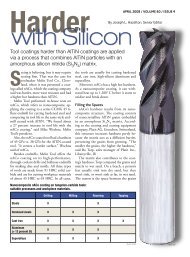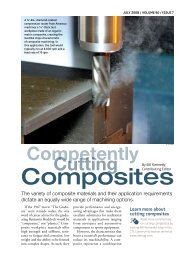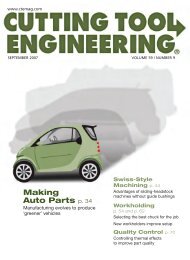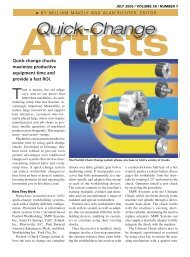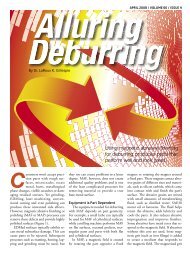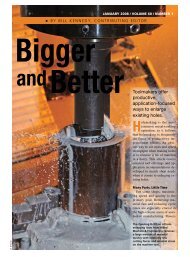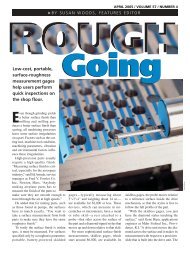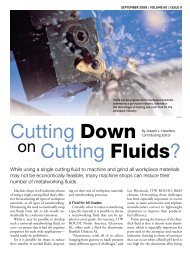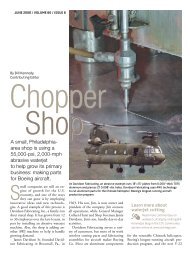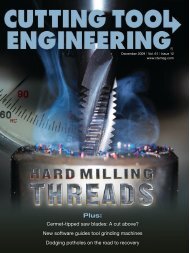A carbide drill designed with two asymmetrically angled cutting ...
A carbide drill designed with two asymmetrically angled cutting ...
A carbide drill designed with two asymmetrically angled cutting ...
You also want an ePaper? Increase the reach of your titles
YUMPU automatically turns print PDFs into web optimized ePapers that Google loves.
chisel edge. Conversely, a robust chisel<br />
edge produces poor centering and high<br />
thrust but can tolerate high feed rates.<br />
Recent studies by the Institut für<br />
Produktionsmanagement, Technologie<br />
und Werkzeugmaschinen Technische<br />
(PTW), Universität Darmstadt, Germany,<br />
showed that as the chisel edge enters<br />
a workpiece, it creates a concave oval.<br />
This causes the <strong>drill</strong> to “swing” in a motion<br />
similar to a pendulum (Figures 2a<br />
and 2b). For ease of description, the <strong>drill</strong><br />
creates a triangular hole; the corners of<br />
the <strong>drill</strong> form the triangle’s points as the<br />
<strong>drill</strong> continues the pendulum motion<br />
created by the chisel edge.<br />
Coupled <strong>with</strong> the feed rate, the <strong>cutting</strong><br />
action is slightly comparable to helical<br />
interpolation, <strong>with</strong> the <strong>drill</strong> margins<br />
typically riding the lead of the chisel edge<br />
throughout the hole. The result is an outof-round<br />
hole <strong>with</strong> poor cylindricality<br />
and, at times, notable deflection from<br />
the centerline.<br />
Cutting forces are not equal per <strong>cutting</strong><br />
edge, so each <strong>cutting</strong> edge is at a<br />
slightly different plane as it follows the<br />
PTW<br />
Figures 2a and 2b: These illustrations show the pendulum motion and its impact on hole<br />
roundness caused by the concave oval that’s created as a conventional <strong>drill</strong>’s chisel edge<br />
enters a workpiece.<br />
pendulum. Geometric deviations found<br />
in the <strong>drill</strong> grinding process, such as unequal<br />
hones on the <strong>cutting</strong> edges and<br />
symmetry errors, also contribute to creating<br />
asymmetric <strong>cutting</strong> forces.<br />
Material Matters<br />
High-tensile-strength workpiece materials<br />
compound the issues previously<br />
noted. However, the aerospace, energy,<br />
food processing and medical industries<br />
desire parts made of those materials.<br />
When machining these materials, machine<br />
operators must lower feed rates,<br />
extending the time a <strong>drill</strong>’s chisel edge is<br />
pushing material away before the main<br />
<strong>cutting</strong> edges engage the workpiece. Such<br />
extreme wear on the chisel edge further



